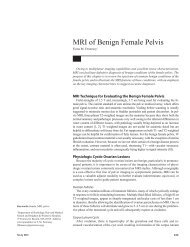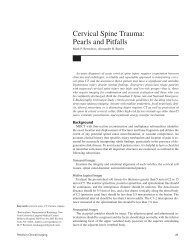Scientific Session 1 â Breast Imaging: Mammography
Scientific Session 1 â Breast Imaging: Mammography
Scientific Session 1 â Breast Imaging: Mammography
You also want an ePaper? Increase the reach of your titles
YUMPU automatically turns print PDFs into web optimized ePapers that Google loves.
<strong>Scientific</strong> <strong>Session</strong> 14—Neuroradiology: Head and NeckWednesdaysidered as fatty when the density value was less than 60 HU, mixed from60 to 130 HU, and calcified if greater than 130 HU. Patients underwenten bloc carotid endarterectomy, histological sections were analyzed, andthe presence of intraplaque vessels was quantified.Results: A total of 470 histological sections were obtained and we observeda correspondence between histological sections and unenhancedCT sections in 90.6% of the cases. Correspondence between histologicalsections and CT after administration of contrast material was observed in75.4% of the cases. The difference between the groups was statisticallysignificant (p = 0.0019). In the 63% of the discrepant cases, presence ofintraplaque vessels was detected.Conclusion: Our results suggest that unenhanced CT is more reliable thanenhanced CT in classification of carotid artery plaque type; the degree ofintraplaque vessels may explain the discrepancy between histology andCT after contrast material administration.121. Echogenic Foci Detected in Thyroid Nodules at Sonography:Predictive Value in Differentiating Benign From Malignant PathologyBennett, G.*; Peck, V.; Kang, S.; Babb, J.; Jacobs, J.; Giovanniello, G.;Slywotzky, C.; Yee, J. New York University Medical Center, New York, NYAddress correspondence to G. Bennett (genevieve.bennett@med.nyu.edu)Objective: To determine if there are sonographic features that allow differentiationof echogenic foci (EF) associated with papillary thyroid carcinoma(microcalcifications) from those associated with benign colloidnodules (comet tail artifact-CT angiography [CTA]).Materials and Methods: Eighty-six thyroid nodules with sonographicallydetected echogenic foci (measuring < 1.5 mm) that underwent cytologicsampling were identified. Four radiologists independently retrospectivelyreviewed nodules for the following: association of EF with cystic changesand CTA, number of EF (percentage of nodule with EF), shape ofEF (linear or round), and distribution of EF in the nodule (scattered orclustered). Readers also evaluated nodule texture, echogenicity, margins,shape, and vascularity. Logistic regression for correlated data was usedto compare cancers and benign nodules with respect to these features.Readers also decided if microcalcifications and thyroid cancer were present.Fisher exact test determined if each reader was more likely to decidethat microcalcifications were present in cancers versus benign nodules.Results: Sixty-five women and 21 men were included, with a mean age of52 years. Fifty-two nodules were benign (49 nodular goiter, three hyperplastic)and 34 were papillary cancer. Nodules ranged from 0.8 cm to 5.8cm. Readers combined had 61.1% specificity, 81.6% sensitivity, and 69.2%accuracy for detection of malignancy based on all sonographic features. Allfour readers were significantly more likely to detect microcalcifications inpapillary cancers (p < 0.001). There was a statistically significant associationwith benign pathology when EF were associated with many CTA andcystic changes (p < 0.0001), whereas there was a statistically significantassociation with malignancy when EF were not associated with CTA orcystic change (p = 0.0001, p < 0.0001). When EF were clustered in thenodule, malignant pathology was statistically more likely (p = 0.0001). Alarge number of EF (occupying > 50% of nodule) was also associated withmalignancy (p = 0.0192). Shape of the EF was not predictive of pathology.Other nodule features that were more often associated with malignancywere ill-defined margin (p = 0.0005) and solid echotexture (p < 0.0001).Conclusion: While features of EF associated with benign and malignantthyroid nodules overlap, when EF are not associated with comet tailartifact or cystic changes, occupy more than 50% of the nodule or areclustered, microcalcifications related to malignancy should be stronglysuspected and tissue sampling is warranted.122. Prospective Study of the V2-V3 Vertebral Artery in PatientsWith Occipitalized Atlas With Emphasis on Surgical ImplicationsMorani, A. 1 *; Parmar, H. 1 ; Goel, A. 2 ; Srinivasan, A. 1 ; Shah, G. 1 ;Hoeffner, E. 1 ; Mukherji, S. 1 1. University of Michigan, Ann Arbor, MI;2. KEM Hospital, Mumbai, IndiaAddress correspondence to A. Morani (amorani@med.umich.edu)Objective: To study the course of the V3 segment of vertebral artery (VA)on CT angiography (CTA) in patients with occipitalized atlas (OA) and tostudy the parameter for safe surgical dissection at the craniovertebral junctionin these patients, to avoid the potentially detrimental risk of VA injury.Materials and Methods: Preoperative CTA with 3D volume reconstructionswere prospectively performed in 24 patients with diagnosed OA ona 4-slice scanner with 1-mm slices. There were 14 male and 10 female patientswith an age range of 13–45 years. The course of V2 and V3 segmentsof VA was studied. The maximum distance of the lateralmost end of theV3-VA where it arches over the posterior arch or the maximum distance ofthe extracranial end in cases of fused posterior arch of atlas was calculatedfrom midline to determine a parameter for safe surgical dissection. Surgicalfollow-up was performed to determine validity of imaging findings.Results: Sixteen of 24 patients with OA had partially OA with fusion involvingthe posterior arch of atlas. Two of these 16 cases had unilateral C2segmental type of VA. Thus V3-VA of two cases (4%) (one artery in each)coursed below the posterior arch of atlas before intracranial entry, while thecontralateral VA coursed through the intraosseous canal in the fused portionof occiput and atlas. Bilateral VAs (n = 46) in the remaining patients coursedthrough the intraosseous canal in the fused portion of OA or coursed abovethe unfused posterior arch in cases of partially OA. Average maximum distancefrom midline of the extracranial end (with fused posterior arch) or lateralmostend (along unfused posterior arch) of V3-VA was 23.5 mm.Conclusion: The majority (approximately 96%) of VAs course throughthe intraosseous canal in the fused portion or above the unfused posteriorarch, in cases of OA. Some patients can have a C2 segmental type of vertebralartery. CTA is very useful to assess the relations and course of V3-VA with important surgical implications at the craniovertebral junction.Using CTA, distance from midline can be calculated, for the lateralmostend or extracranial end of V3-VA along the unfused or fused posteriorarch of atlas. Surgeons can dissect safely along the posterior arch of atlas,up to this distance from the midline, without damaging VA in such cases.123. Intranodal Cystic Changes: A Potential Radiological Signature/Biomarker to Assess the Human Papilloma Virus Status of PatientsWith Oropharyngeal CarcinomaMorani, A.*; Shah, G.; Eisbruch, A.; Carey, T.; Davis, S.; Mukherji, S.University of Michigan, Ann Arbor, MIAddress correspondence to A. Morani (amorani@med.umich.edu)Objective: To determine if there are lymph node imaging findings thatcan predict human papilloma virus (HPV) positivity in patients with oropharyngealcarcinoma (OPC).A46*Will present paper
















